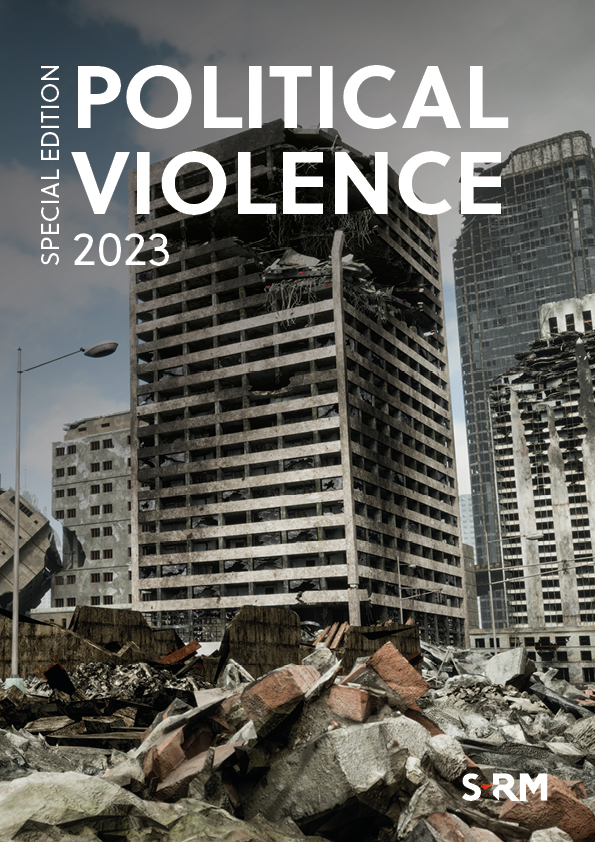Warfare between states has undergone a continuous evolution; from first, second and third generation warfare which comprised traditional combat, to the fourth generation characterised by the growing involvement of non-state actors like terrorist groups, through to the fifth and current generation (5GW) driven by the digital age and a ubiquitous battlefield not confined to the physical realm. Markus Korhonen and Erin Drake write that this latest generation is increasingly reflected in current geopolitical disputes and tensions as states lean on ‘grey zone’ tactics to secure their goals – with significant implications for commercial operators.
Modern conflict – particularly in the context of globalisation and advancements in the digital space – has necessitated shifts in approaches to strategic rivalries as states grow wary of the costly implications of military action. Russia’s invasion of Ukraine has come at a steep domestic price for Russia, paralysing several industries and setting the economy back by an estimated four years due to an international sanctions regime and the cost of maintaining a protracted conflict on foreign soil – at the same time, it has cost the global economy around USD 2.8 trillion. It has also come at some political cost to President Vladimir Putin’s regime, with rising popular discontent domestically and increasing dissatisfied rumbling among some former allies among its near neighbours. This conflict and the US withdrawal from Afghanistan have highlighted the drain both on public finances – estimates put the cost of the US’s 20-year war in the country at some USD 2 trillion – and on domestic support for war-waging governments, but also the detrimental macroeconomic impact of hot wars in a connected global economic system, and the punitive repercussions of not playing by international rules of engagement. Simultaneously, technological advancements and skyrocketing online public engagement in recent years have shown the strategic value in adopting alternate pressure tactics that blur the line between war and the absence of it.
“With military strength a much less potent indicator of international influence and prestige than it was in previous eras, the use of force may be increasingly shunned in favour of methods and tools of subversion that leverage political and economic power.”
Crucially for the commercial sector, grey zone tactics – actions that stop short of direct ‘hot’ warfare but are nevertheless intended to pressure or coerce rivals – have considerable direct and indirect implications for business operations. With a growing range of options available to state actors, and in a climate of rising geopolitical tensions, an understanding and ongoing monitoring of geopolitical developments become increasingly vital to businesses wishing to prepare for and navigate the fallout from less clearly defined coercive actions, along with the deepening uncertainty it heralds.
The concept of hybrid warfare is not new, although the Russia-Ukraine conflict has catapulted the term into the global spotlight in 2022. While hot wars comprising direct military engagements remain active in several locations around the world, interstate wars like the Russia-Ukraine war and the Nagorno-Karabakh war in 2020 are rare, and many of these comprise civil conflicts between armed groups and their governments. Nevertheless, hybrid approaches, coupling skirmishes with other asymmetrical tactics, are commonly used. In Yemen, the Horn of Africa, the Sahel and Mozambique, for example, extremist groups and security forces regularly employ weaponised drones in targeted strikes. Iran’s support of Shia militias across Iraq and Syria, combined with regular cyber warfare and other coercive tactics aimed at a range of targets both domestic and foreign, is another example demonstrating a blend of approaches for achieving political aims.
case studiesThe Crimean invasion
Russia’s hybrid approach is longstanding; in its 2014 invasion of Crimea, Russia shut down Ukrainian media stations and replaced them with Russian media to construct propaganda narratives, disseminated through social media campaigns, around the historical relationship between Russia and Crimea, and Ukraine’s alignment with the West. Proxy civilian groups like the pro-Russian neo-Nazi Pravy Sektor and Azov Battalion were deployed to wage these campaigns, while hacktivists and hackers carried out cyberattacks against financial software companies.
The Ukraine invasionWhile the Crimea invasion relied on undermining Ukraine’s energy diversification strategy and deepening Crimea’s energy dependence on Russia, its current efforts have involved pressuring European governments through cutting energy supply to the continent by around 88 percent, including through the suspected sabotage of the Nord Stream 1 pipeline. Russia’s tactics in 2022 have also included intensified disinformation and propaganda campaigns claiming human rights abuses against Russians in Ukraine and exaggerating Russia’s military successes. Meanwhile, it has turned to Latin America and Africa for allies through cultivating trade relationships alongside disinformation campaigns, blaming Western sanctions rather than its own belligerence for escalating food prices, and stoking existing anti-US sentiment. |
BLURRED LINES: GREY ZONE TACTICS GAIN FAVOUR
With military strength a much less potent indicator of international influence and prestige than it was in previous eras, the use of force may be increasingly shunned in favour of methods and tools of subversion that leverage political and economic power. Rapid advancements in technology and shifting geopolitical dynamics have also created new opportunities for influencing global power relationships. The attractiveness of such options in terms of limiting costs – as well as both military and civilian casualties, particularly amid governments’ struggles to maintain public opinion while curbing global inflationary pressures – may sway states’ decision-making calculations towards approaches that are perhaps more effective at bringing about their goals, with a lower risk of attracting unwanted international punitive or retaliatory measures.
DEFINING GREY ZONE TACTICS
Defining a ‘grey zone’ has been historically tricky, with one former Pentagon adviser pointing out that in a grey zone, ”we don’t know what counts as ’armed conflict‘ [and] we’re no longer even sure what counts as a weapon.“ Simply, the grey zone refers to a non-physical arena of warfare in which actors use tactics that are considered grey areas in terms of their il/legality, particularly under international law and the rules of engagement. Grey zone tactics can be coupled with conventional warfare as part of a hybrid approach but can also be used in isolation as an alternative to engaging in a hot war. |
Grey zone tactics encompass a wide range of activities, from state-sponsored kidnappings of dissidents, to tampering with elections, and to proxy terrorism, alongside several others. Here we highlight three avenues where grey zone tactics have been used as a means to undermine rival states.
1. Disinformation and Democracy
In a world of social media, governments have leveraged platforms like Facebook and Twitter to influence public opinion in rival or allied countries through disinformation campaigns or troll farms, created to discredit opposition or activists and journalists. Russian enthusiasm for these activities is well documented, but while grey zone tactics are often associated with authoritarianism, or presented as a threat to democratic society, some of these tactics are equally employed to promote the interests of democratic states. In July and August 2022, Twitter and Meta removed a series of accounts for violating their respective terms of use. Following this, an investigation by social media analytics firm Graphika and the Stanford Internet Observatory identified dozens of accounts across eight different platforms that were engaged in campaigns to promote pro-Western narratives in the Middle East and Central Asia. While the details of the accounts were not made public, it appears they originated from the US and UK, and were aimed at promoting the interests of the US and its allies in opposition to countries such as Russia, China and Iran.
2. The Cyber Age
The drive to gain technological supremacy, particularly over emerging technologies like artificial intelligence, is driving growing competition between nation-states through legitimate and illicit means. Efforts to seek IP or monetary advantage, or to disrupt other countries’ infrastructure or commercial operations, has opened a new frontier that straddles the line between overt hostility and covert action. The targeting of Iranian nuclear activities with malware over at least the last decade, most likely by US and Israeli operators, has been widely written about, but more recent examples abound. The 2020 ‘SolarWinds’ hack by a Russian state-sponsored group led to the breach of at least nine US government agencies along with more than 100 companies. A series of cyberattacks in Australia in 2022, which Australian authorities blamed on Russian groups, saw an estimated 14 million user accounts of a major telecommunications company and the country’s largest medical insurance provider compromised, and a separate ransomware attack targeted a communications platform used by the Australian military. And in July 2022, cyber actors with close ties to the Iranian regime successfully disrupted Albanian government computer systems, prompting a shutdown of public services. The cyber space provides a valuable and expanding battleground for grey zone operations, where plausible deniability can dampen the casus belli for retaliation.
3. Economy under Pressure
As all states seek economic advantages, the degree to which economic actions of states can be considered a grey zone tactic epitomises the definitional ambiguity of the concept – at what point does the acceptable pursuit of economic objectives move into the realm of coercion? Recent tensions in the South China Sea have demonstrated the entanglement of economic and political interests, with players on all sides employing non-military (although not exclusively) approaches to achieve an advantage. Separately, Russia’s manoeuvrings around grain shipments from Ukraine via the Black Sea – as well as in other commercial arenas – have been a demonstrative case of its hybrid approach to warfare, as well as exposing Russia’s increasing isolation and its concomitant need to resort to a wide array of tools to limit the impacts of its military shortcomings in Ukraine. The increasing rarity of interstate war over the past decades is in itself a clear indication that interstate tensions are far more likely to manifest as economic wrangling, in turn suggesting that the targets of hostile action will increasingly be the boardroom rather than the bunker.
SHOULD BUSINESSES BE WORRIED?As various geopolitical disputes and tensions continue into 2023, states will continue to adapt and utilise all available advantages to secure their position in the global order. However, this presents a range of direct and indirect challenges for commercial operators. Energy-intensive sectors, particularly in Europe, will continue to face disruptions as Russia leverages European dependence on its gas resources. US-allied companies operating in the digital, scientific, and technological sectors face an elevated threat of IP theft and cyberattacks as rival states seek rapid competitive advantage amid trade disputes, technological decoupling, and a likely deepening of AI-enhanced military equipment. The global agricultural and food retail industries will also continue to experience disruptions as supply chain bottlenecks and fertiliser shortages threaten crop yields and drive food insecurity. Global businesses across the board need to consider how they navigate a |




 Email Markus
Email Markus






 @SRMInform
@SRMInform
 S-RM
S-RM
 hello@s-rminform.com
hello@s-rminform.com

